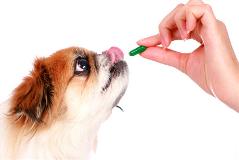Advancements in the Forms of Medicine Delivery

It is often the smallest of pets that are the feistiest when coming in for a sick or wellness visit. If they have ever been to the vet before the chances are good that they have an idea as to why they are there now, and pets that are sick or already stressed can be difficult to deal with when they are getting poked or have nasty tasting stuff put in their mouths.
Forms of Medicine Delivery
Animal medications come in many methods of delivery. Veterinarians and their staff are trained to administer these various forms, but clients who must complete the doses at home often struggle, and sometimes the entire prescription ends up not being used.
- Pills, capsules, powders
- Often have a bad taste.
- Not all animals are compliant, and some may bite.
- Clients may find it difficult to get the pill in the right spot so the animal swallows it.
- Pills that do not go to the stomach, but instead sit in the esophagus may cause vomiting, irritation to the lining of the esophagus, stricture or ulcers.
- Liquids
- Often have a bad taste.
- Clients may find it difficult to get the dose in the right spot so the animal swallows it.
- Can be very messy.
- Sometimes it is difficult to know if the animal received the correct dosage.
- If the animal objects, it may bite.
- Injections
- Can cause an allergic reaction or anaphylactic shock.
- Not always painless and the animal may panic and bite.
- Clients may be opposed to continuing shot administration for their pet at home.
- Nasal sprays
- If the animal doesn’t hold still it is difficult to administer the correct dosage.
- Often cause sneezing which forces the medicine out and into the air and animal doesn’t get complete dose.
- Suppositories
- Should not be given to animals that are dehydrated or could possibly have a bowel obstruction.
- Spot on doses and gels
- Can be messy.
- Can cause adverse effects if the dosage is not correct.
- Can cause adverse effects if another animal comes in contact with the product.
While there are many options, not all methods work for all animals which is why pharmaceutical industries put great effort into looking for new ways to help with the problems of administering medicines.
Injection Free Applications
One of the most recent developments in the administration of veterinary medicine focuses on injection-free applications.
Dermal Patch
One example of an injection-free application is the dermal patch. This method has been utilized for human needs for quite a while, but is just now being introduced for use within the veterinary community. The dermal patch works in the following manner:- Patch is attached to the skin by an adhesive layer.
- Protective backing holds a small reservoir of the medicine.
- Reservoir of medicine is held inside a rate-limiting release membrane.
The patch requires the drug to be of high potency, low molecular weight, and both water and lipid soluble.
- Water solubility allows for the drug to move out of the small reservoir and through the top layer of the epidermal skin down through the dermal layer.
- Lipid solubility allows for passage through the outermost layer of the epidermis.
One example of the use of a dermal patch in veterinary medicine is the fentanyl patch, a prescription skin patch that is used for pain management; for example, following animal surgery.
Transdermal Delivery Gel
A second type of injection-free medicine application is transdermal delivery gel, also known as Pluronic Lecithin Organogel (PLO) gel. The gel is a base in which medicine can be incorporated for use as a transdermal drug delivery system. In animals the gel:- Is blended with the appropriate medicine.
- Typically administered to the ear area of the animal.
- Medicine is delivered across the skin and into the bloodstream of the animal.
This method is currently being used in both dogs and cats for the treatment of hyperthyroidism, cardiac disease and certain behavior issues. Need more advice on medication disbursement? Contact your Covetrus rep today!
Careers
Are you looking for a place to let your talents shine? At Covetrus, we help our practitioner customers better serve their patients and take pride in providing the best customer experience possible. Search our open positions to see our available opportunities.
Newsletter
Stay current with what’s going on with Covetrus, subscribe to receive our newsletter and email communications. Subscribers will receive the latest information in practice management, sales and marketing, animal health, and more.


Leave a comment